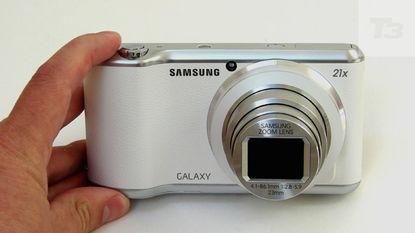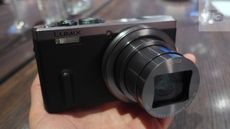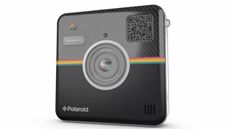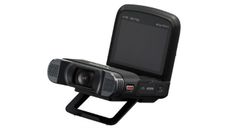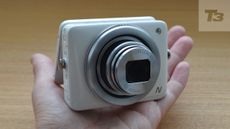Is this second-gen Android camera the best choice for a smartphone-like experience from a dedicated device? Find out in our Samsung Galaxy Camera 2 review
Do we really want our dedicated cameras to be more like our smartphones?
We've seen manufacturers bringing out higher priced, more fully featured cameras with retro styling and gorgeous builds like the Fujifilm X-E2, the Olympus OM-D and the new Leica T family to suggest to consumers here's what you could be using if you're prepared to step away from the smartphone. Arguably such cameras are as much photographic 'jewellery' as they are image capture devices.
Samsung, however, thought it could offer the best of both worlds. Its futuristic-looking, forward-thinking Samsung Galaxy Camera of 2012, on release hailed as the world's first ever Android OS powered compact, sought to combine what cameras do best with what phones do best.
Unlike those rivals mentioned above, there is no harking back to yesteryear for Samsung. And, at the time, it was exciting to hold in our hands a camera that could browse the internet and download games and apps, as well as shoot decent pictures and video.
All this is still true of the logically named Samsung Galaxy Camera 2 upgrade, again arriving with an Android OS – Android 4.3 Jellybean to be exact – and smartphone-like apps presented via a huge touchscreen at the back.
In its favour there is a lack of competition for an Android-powered camera. The main rival is still the Nikon S800c and newer Nikon S810c, a Wi-Fi and Android OS equipped 16 megapixel, 12x optical zoom snapshot.
Though we've yet to take a look at the newer Nikon, the original S800c felt like a half-hearted embrace of the technology compared to the much more fully realised Samsung.
So what's changed with the Galaxy Camera 2 that may tempt the amateur photographers who didn't bite the first time around?
Well, while the optically stabilised 21x optical zoom remains the same, here starting at a wide angle 23m in 35mm terms, its upgraded successor looks marginally more premium with a silver top and base plate plus a roughened leather effect surface covering not just the grip, but additionally the entirety of the faceplate.
This seems to be mainly a stylistic decision as the surface didn't actually appear to make for a tighter grip during use.
Also remaining the same is a 16-megapixel resolution from a back-illuminated 1/2.3-inch CMOS sensor, meaning that the tweaks are mainly under the bonnet, in the form of an upgraded 1.6GHZ Quad Core processor, an 8GB internal memory capacity, Samsung's usual sweetener of 50GB of Dropbox storage, plus NFC connectivity.
However Samsung has chosen to omit a slot for a SIM card this time around, which is interesting, though a vacant MicroSD card slot remains allowing for an optional capacity expansion up to 64GB.
So at first glance, changes appear to be a boost in power and performance rather than a branch and root review.
Samsung Galaxy Camera 2: Controls
Once the camera is powered up and ready to go, using it is pure pleasure. The beauty of the Galaxy Camera 2's icon-led, app-style controls and touch screen is naturally that its operation will be immediately familiar to anyone who has used a smartphone or tablet, especially something like the Samsung Galaxy S5. So that's just about all of us under the age of 75.
As with its predecessor, the Galaxy Camera 2's few physical controls remain restricted to its top plate.
The dedicated button for raising the pop-up flash has gravitated on this model, having formerly been located on the camera's flank. Press this button and the flash juts out and hangs forward rather than rising straight up; not that it makes a lot of difference in terms of performance.
This control joins a teeny, recessed power button and a larger, raised shutter release button, the latter once again encircled by a lever for operating the zoom. This lever presents a ridged edge to prevent it from slipping when under the thumb.
The layout and positioning of these last three controls remains exactly the same as on the original Galaxy Camera. But with this device, operation really revolves around use of the screen, which brings us onto...
Samsung Galaxy Camera 2: Screen
Though the width of this second-generation model is slightly wider than the first, the core screen size and surrounding bezel width on the back plate has remained exactly the same in size.
Fair enough, as for a dedicated digital camera, the Galaxy Camera 2's screen is already huge at 4.8 inches, with a respectable resolution of 921,600 dots that ensures details look sharp, even when parting your thumb and forefinger to enlarge a captured image on screen.
This usability is obviously a big asset given that physical controls have been paired back to the minimum, meaning that all the camera's shooting modes have to be selected and implemented via the screen also.
As well as being a practical concern, the bigger than average screen means that the Samsung is a camera that's built for sharing images with - we don't just mean via Wi-Fi and NFC, but also in the traditional sense of simply inviting friends and family to crane their necks to view the shot.
Here we get a widescreen view and by default the camera's setting is to shoot in 16:9 format, which actually delivers a still image size of 12 megapixels, as effectively we're cropping the image.
We get the full resolution 16 megapixels instead by manually selecting the standard digital image ratio of 4:3, even if this does have the effect of introducing black bands left and right on screen, as the image sits in the centre.
It's worth noting that your shots will look sensational displayed on the back of the camera - colourful, richly detailed and providing plenty of contrast.
However, as with all screens, if you're shooting in bright sunlight it can be a little difficult to view without the failsafe of cupping a hand around it to shield it from the glare.
Samsung Galaxy Camera 2: Apps
The core 'camera' part of this device is presented as an app in itself. Tap this on the touchscreen and we're then presented with the scene before the lens, just as we would be if operating any smartphone.
If the camera has gone into sleep mode between shots a second press of the power button will immediately bring you back to where you left off with the camera; there's no need to start with the home screen, which we can trace our way back to via the familiar house icon top left of screen.
To get the most out of the camera you can install a dedicated Samsung Smart Camera App on your phone, allowing it to act as a remote viewfinder if so wished, as well as providing a means of automatically beaming and sharing shots.
But there is plenty that you can do with this camera from the off, including diving straight into the Google Play store, uploading images to Dropbox over Wi-Fi or even browsing the web.
Of course, big though it is, and being comfortably comparable to your average smartphone, the screen still feels a little small compared to the option of a tablet for longer term browsing.
Samsung Galaxy Camera 2: Battery
Packed into a tight little box on delivery, very much like your average smartphone, there is no room provided for a standalone charger.
We just get a USB lead and a suitably enabled mains plug via which the battery is replenished - inexplicably black with our review sample, though the actual camera was white and silver - while remaining within the camera at all times.
There's also the option to charge the camera from your laptop if in a fix via the same supplied lead. Power duration is good for around 400 shots from a full charge, which is certainly much, much better than most snapshot cameras, even ones that don't feature huge screens and GPS to potentially drain juice faster than a thirsty toddler.
Samsung Galaxy Camera 2: Picture quality
Despite offering a fairly bright f/2.8 maximum lens aperture, it's slightly disappointing for us that the Galaxy Camera 2 doesn't feature a larger APS-C sized sensor as found in the brand's Samsung Galaxy NX interchangeable lens camera range; an idea we put forward to the manufacturer's Korean top brass on the original's launch two years back.
Also, stills capture format remains compressed JPEG only, so this is in many ways a snapshot camera at its heart and in spite of a £400 asking price.
That said its shots look great - for a snapshot camera - with plenty of colour and detail ensuring that we didn't feel the need to tweak the images straight out of the camera.
If you want to shoot video it's a case of navigating your way to that option on screen. Press the video camera icon to activate that mode and the camera immediately begins recording, whereas we would have liked to be presented with a record button first and foremost. Still, once you know this is the case you can avoid shooting footage of your shoes.
As one would expect, the full extent of the 21x optical zoom can be used for both videos and stills, focus adjusting automatically - albeit a little sluggishly in lower light - if swapping subjects or changing framing mid stream.
Samsung Galaxy Camera 2: Verdict
The 16 megapixel, 20x optical Samsung Galaxy Camera 2 is is a refinement rather than the revolution its predecessor offered at the time. While it feels too 'gadget-y' for true photographers and a little bulky for smartphone users who covet their slender handsets, if you're looking for a jack of all trades to take on your travels and want a simple means of posting and emailing images while doing so, it may well fit the bill.
There's also the Samsung Galaxy K Zoom handset, coming after the Samsung Galaxy S4 Zoom which didn't exist when the original Galaxy Camera was launched, to further muddy the waters between phone and camera.
With this offering a 10x zoom lens and higher resolution 20.1 megapixel sensor from a slimmer and more pocketable device, it will be interesting to see where that leaves the Galaxy Camera 2. We would've liked to have seen a bigger improvement on the second-gen camera, as it doesn't really warrant upgrading from the first model.
Samsung Galaxy Camera 2 release date: Out now
Samsung Galaxy Camera 2 price: £399
